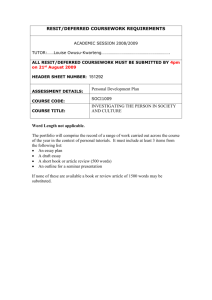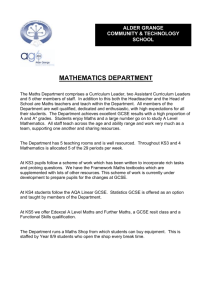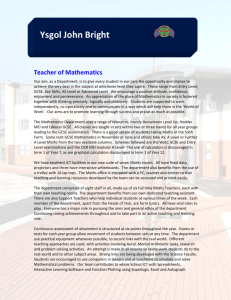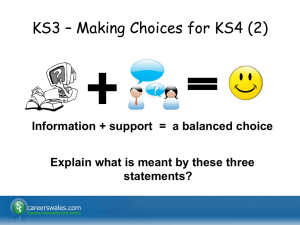Making Sense of Algebra
advertisement
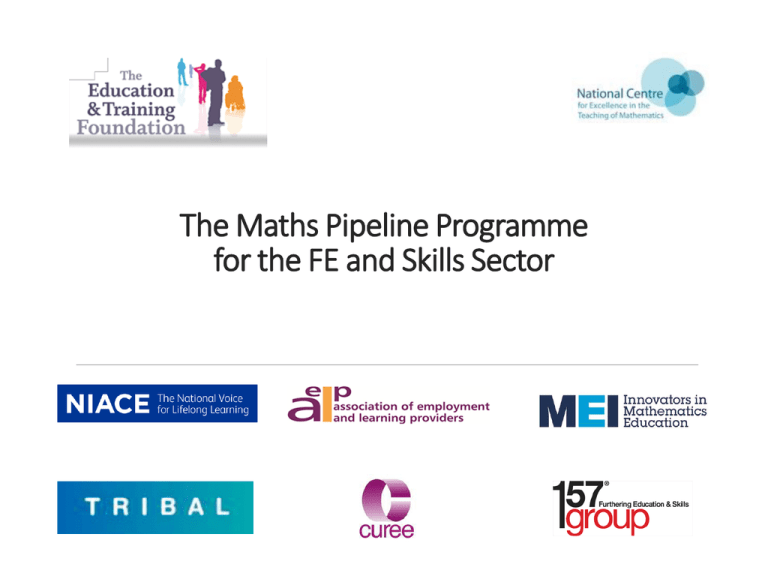
The Maths Pipeline Programme for the FE and Skills Sector Post 16 GCSE resit: A Nuffield funded project developing a new approach to GCSE resit Based on Realistic Mathematics Education S.HOUGH@MMU.AC.UK Today’s session Background to the project Student responses pre and post Intervention Working with the materials Problem Solving 1 1 4 2 DO YOU THINK YOU HAVE GOT THIS RIGHT? EXPLAIN WHY. Year 11 % correct % Correct Fractions Target Target N=50 grade C Grade D/E Project 83% 57% Control 72% 30% Pupils may attempt to solve a problem by Engaging solely with the numbers Attempting to make sense of the problem GCSE resit students What do these students look like? GCSE resit cohort - Mathematical issues Memory of formal methods can be poor Use of misremembered strategies – ‘doing something with the numbers’ Desire to use informal methods – these tend not to have been developed to a more efficient, ‘of worth’ level GCSE resit cohort – attitudinal issues Repeated failures in the examination Lack of confidence + belief ‘Oh no not this again’ GCSE resit cohort – Some Teacher dilemmas How to cover the syllabus in 9 months (or less) How to cope with the variety of methods students may bring Realistic Mathematics Education (RME)- the Dutch approach to teaching maths Well researched activities encourage students to move from informal to formal representations of maths Use of context is sustained throughout Use of models to support student development Progress towards formal notions seen as a long term process RME, MMU and Post 16 GCSE resit MMU have worked on RME related projects for the last 13 years ‘Making Sense of Maths’ series published by Hodder, written by MMU with support from the Dutch Has the potential to offer students a different approach to GCSE resit MAKING SENSE OF MATHS’ SERIES PUBLISHED BY HODDER ‘ Nuffield Funded GCSE RESIT Project 4 project and 4 control classes in three sites Intervention consists of Number and Algebra modules Data includes: pre and post tests, attitude data, post test video interviews, teacher interviews Post- test script - rates Post-test - rates Post-test script- percentage Examples of the Material Use of context Use of models The Download Bar This is an image of a download bar on a computer. 1) When did you last see something like this? 2) What information is there in the window? 3) How long has the program been loading so far? 4) How many megabytes (MB) are there left to load? The Download Bar On Worksheet N1, work out the total installation time for each of the 9 bars. 1. Work out the total installation time for the program below: 0 4 0% 25% ? minutes 100% Now work out the total installation time for this program: 2. 0 9 0%10% ? minutes 100% The Download bar Reverse Percentage Calculations Susan sold her car for £6820. This was 20% less than she paid for it. How much did she pay for the car? Draw a bar to represent this information Pre-test – reverse percentage Post-test – reverse percentage Buying ribbon Louisa is a dress maker. She uses ribbon to edge her garments as a way of making her designs stand out. Louisa buys a sample of the ribbon shown below: a)It costs her £ 1.16 for 80cm of the spotty ribbon. Draw a picture to represent this information and make it look realistic b)What else do you know? Mark on your picture some other quantities of this ribbon, which you would know the cost of. Sharing Food The café where Ruby works specialise in making large rectangular pizzas. These are popular with lunch time diners who often order one of the large pizzas to share. Masood and Tim are students. They meet for a pizza in the café once a week. On one occasion they order the rectangular cheese and tomato pizza shown below costing £10.35. Tim is not as hungry as Masood, so they cut the pizza into 9 slices, Tim eats 4 slices and Masood eats 5 slices Draw a picture to show how they might share out the pizza Share out the cost of the pizza between Masood and Tim in the ratio 5 : 4 Post-test- ratio Post-test - ratio Can this be true? I’ve got an 80 waist How can this be true? You need to sort that out. Mine’s only 40 Extending the Number Line Unlike many countries, in the UK we still use two different units for measuring length. Both of these can be seen on a standard tape measure. The tape shows that 6 inches is roughly the same as 15 cm. What do you think 12 inches is in centimetres? The Number bar Daniel drew the number bar above to represent the tape measure 1. Make a copy of this bar and mark four other points on it that you know in both centimetres and inches. 2. Mark is 5 ft and 3 inches. Alexandra is 1 metre and 72 centimetres. Use the 30cm to12 inches rule of thumb to decide who do you think is the taller of the two? Recipes – the ratio table Helen decides to use the ratio table below to work out the ingredients needed for different numbers of pancakes. Pancakes Makes 8 pancakes Ingredients 125 g plain flour, sifted 1 medium size egg, beaten Copy the table and fill in four more 300 ml milk columns showing the ingredients a little oil for frying needed for different numbers of pancakes Best buy – ratio tables In the supermarket, Helen and Nisha are buying ingredients for other pancakes and trying to make sure that they get the ‘best buy’ Which do you think is the best buy? Best Buy To work out which is the best buy, they decide to use a ratio table. They begin by doubling to see if this helps them to compare the two buys. After a few minutes, they both have exactly the same thing on their notepads. It looks like this: Can you decide from here which is the ‘best buy’? From the original table above, Helen and Nisha then work in slightly different ways to make a comparison easier. Below is their working. Explain carefully what each of them has done and how you can now see which is the best buy. Starting the ratio table For the next questions, draw your ratio table and fill in four other sets of values that you know to be true. 1) A hare travelling at top speed can run 260 metres in 12 seconds. What else do you know? (30 secs) 2) 8 metres of ribbon costs £4.80 What else do you know? (30 metre 3) 5 miles is roughly 8 km. What else do you know? (120 miles) 4) To make pink paint Joel uses a ratio of 4 parts red to 10 parts white. What else do you know? (30 RED) 5) A printing machine can produce 24 copies in 30 seconds. What else do you know? (95 SECS) Menu Back Forward Cont/d Idea Vocabulary Q 1 6) A multipack of crisps contains 15 bags. What else do you know? (12 MULTIPACKS) Opinion 1 Opinion 2 Answer Q2 Opinion 1 Opinion 2 Answer Some early findings Easier for the adults to take on the approach than the 17 year olds Time is required to develop the approaches Students are able to recognise the potential for using the bar and the ratio table to answer questions in a variety of topics, and do so several weeks later. More difficult to have impact in the Algebra module Some early recommendations Teachers need support to take on this approach in the way it is intended Students who narrowly missed a grade C may do as well to be taught topics in the ‘usual’ way Students who are at Grade E or below could really benefit from this approach if it is used over a two year course

